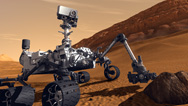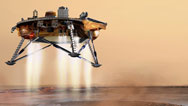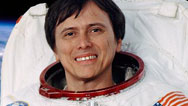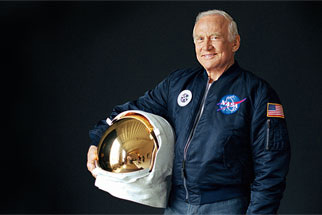A Mission To Mars
- By David Levin
- Posted 11.18.10
- NOVA scienceNOW
As the second person to set foot on the moon, Buzz Aldrin knows a thing or two about visiting other planetary bodies. He's dismayed by the fact that astronauts haven't ventured farther than our closest celestial neighbor and wants to put humans permanently on Mars. In this interview, hear his ideas on how and why he thinks it should be done.
Transcript
A Mission To Mars?
Posted November 18, 2010
DAVID LEVIN: You're listening to a NOVA podcast. I'm David Levin.
While researching an article about potential human missions to Mars, NOVA Online's Peter Tyson called up some leading experts on space flight—including Buzz Aldrin, the second man to set foot on the moon. They talked about whether humans should go to the Red Planet, how NASA might actually get there, and more.
Here are some highlights from the interview. We've edited them down for this podcast.
PETER TYSON: Would you advocate for a one-way mission over a round-trip mission at this point?
BUZZ ALDRIN: I wish you wouldn't call it that.
PETER TYSON: A one-way mission, you mean.
BUZZ ALDRIN: Yeah, yeah. the pilgrims on the Mayflower didn't talk about a one-way trip. They came over here to settle. They didn't hang around Plymouth Rock.
PETER TYSON: Okay, so you see this as the first step to a permanent base on Mars?
BUZZ ALDRIN: Yes. Yes. I'm not sure I'd even call it a first step. I'd call it, "Initiating permanent human presence at Mars."
PETER TYSON: Do you think that the American public would be behind the idea of either a one-way colonizing mission or round trip missions to Mars? Would they back this? All the expenditure that would be needed for this?
BUZZ ALDRIN: I think there would be no shortage of applicants to the government astronaut corps to be settlers on the planet Mars. And I think this would be very inspiring. I think it would be a tremendous boost over the brief visits to the moon we had 40 years ago. And the rather non-inspiring though scientifically productive flights of space shuttles in the last 30 years up to the space station. I think both the space shuttle program and the International Space Station program have not really lived up to their expectations.
PETER TYSON: So, do you see it as inevitable that we will have a permanent presence on Mars within, say, a few hundred years? Do you think it's inevitable? Or do you think it's still very much an open question?
BUZZ ALDRIN: I think it's inevitable that there will be Earthlings establishing a presence on Mars. And I would say that it would certainly take place by 2050 or shortly thereafter. And it's a question of whether we take up—we in the United States—take up the opportunity to do that and inspire our young people, develop the work force in science technology, engineering and math to support this and to make sure that the aerospace industry, which provides our national security, is second to none in the world.
PETER TYSON: And if Russia or China or India were to announce a manned mission to Mars, would that jumpstart NASA, Congress, the U.S. President, do you think?
BUZZ ALDRIN: Well, I certainly think so. I think we, because of the efforts of Apollo 40 years ago, established a clear leadership position. But I think we have to be aware that other nations are catching up and threatening that leadership. And to answer your question, yes. If Russia were to announce that, I think they would certainly steal the headlines. Maybe not quite the way Sputnik did or Yuri Gagarin's flight. But in my estimation, I would say that if we don't kind of shape up what we're doing, we're going to find the Russians clearly leading missions to Mars. And probably attempting to get us to pay for it as a partnership.
PETER TYSON: I've heard other experts talk about the idea that unlike in the Apollo days when Kennedy made that announcement, "Within ten years, we have to get to the Moon," in those days, there was no chance to know everything that had to be done. There were things like microcomputers that hadn't been invented, and yet they just went for it. And that that kind of thinking today wouldn't hold. If we don't know how to do it, we won't do it. Do you think that's true?
BUZZ ALDRIN: I think in general, we have quite a good idea how to do it. The design efforts of NASA have not included three distinct strategies that I think need to be strongly considered. Number one is specialized spacecrafts. So we have a commercial spacecraft up to Earth orbit and back down again for the return and the delivering of crews that then get in redundant, reusable spacecraft that then would go to visit comets, asteroids, or intercept another specialized spacecraft that delivers people to the vicinity of Mars. And then comes back to the Earth and continues to do this every 26 months. And when crews then arrive in the vicinity of Mars, they would occupy the Moon of Mars, Phobos, for a year and a half roughly. Eventually, when we are satisfied, we would deliver the crew directly on the place that we've established to set up the first Mars settlement and colonization.
PETER TYSON: One last question. Would you go on a mission to Mars if they invited you to today? If it were safe?
BUZZ ALDRIN: Well, I hope to be around to watch the final plannings. But I guess there's several views. I'm not sure that I'm the most compatible person for very long missions and I don't think I'll be offered anything in the foreseeable future. And I think my value to the country that I have chosen to serve in my life is to remain here and to use my intellect and experience to help guide the missions that will be conducted by others.
PETER TYSON: Great. Well, thanks very much, Dr. Aldrin. I really appreciate it.
BUZZ ALDRIN: Wonderful. Thank you very much.
Credits
Audio
- Produced by
- David Levin
Image
- (Buzz Aldrin)
- Courtesy Buzz Aldrin
Related Links
-

Ultimate Mars Challenge
In its search for life beyond Earth, NASA employs a "sky crane" maneuver to land the Curiosity rover on Mars.
-

A One-Way Trip to Mars?
Initial shock aside, some space scientists argue this is the only way to go.
-

Phoenix Mars Lander
NASA's latest robot has already found frozen water and is looking for more signs that the Red Planet could support life.
-

Profile: Franklin Chang-Diaz
The first Latino-American astronaut is also a scientist designing a new generation of plasma-powered space vehicles.
You need the Flash Player plug-in to view this content.




